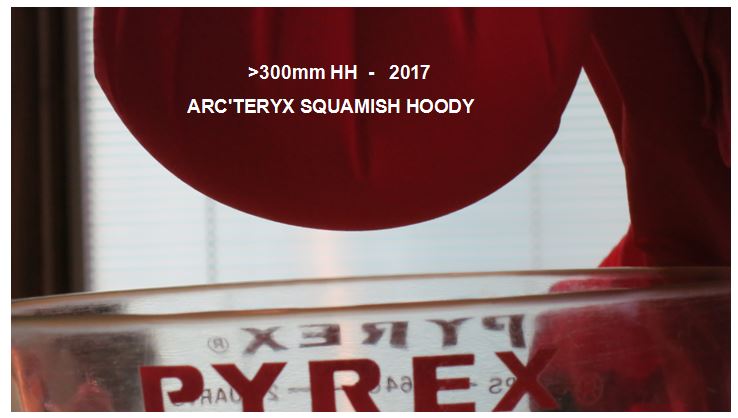Topic
A NEW PARADIGM FOR ANALYZING PWPB SYSTEMS LIKE THE COLUMBIA OUTDRY EX FEATHERWEI
Forum Posting
A Membership is required to post in the forums. Login or become a member to post in the member forums!
Home › Forums › Gear Forums › Gear (General) › A NEW PARADIGM FOR ANALYZING PWPB SYSTEMS LIKE THE COLUMBIA OUTDRY EX FEATHERWEI
- This topic has 234 replies, 7 voices, and was last updated 4 years, 10 months ago by
 Richard Nisley.
Richard Nisley.
-
AuthorPosts
-
Mar 11, 2018 at 9:21 pm #3523805
A few random questions, not exactly PWPB related: how much does regular DWR contribute to the hydrostatic head of the usual windshirt? Obviously, they wet out way faster without DWR – but does the HH go down equally, and to what degree?
Do any of the known EPIC fabrics have stretch in them and if they do, is it a significant amount of stretch?
I’m thinking of making a simple handheld CFM tester. It seems to me you just need a few pipes between which you pin a fabric. You then measure the pressure differential between the sides of the fabric and force air flow until the pressure differential reaches 125 Pa as in most standards and measure the airflow on the other side. With cheap parts and a simple design it won’t be accurate to 0.01 CFM, but for “active WPB” purposes I think it could be accurate within +-10%.
Stumphges: The Alpine Start has 70 CFM? I thought it had 40 CFM, did they change it?
Mar 11, 2018 at 10:31 pm #3523821Ah, thank, so does the DWR also serve as the WPB membrane?
No
Mar 11, 2018 at 10:39 pm #3523824Hi Tuukaa,
Black Diamond says “40 CFM” but even after asking them directly I was not confident that they were not using imperial units, which would convert to 80 CFM, and since Richard Nisley tested the Alpine Start at around 70 CFM, I’ve gone with his measurement. Given Richard’s assertion that the U.S. military has it right with their finding that 25-30 CFM is the optimum for active 3-season pursuits, I would prefer it were 40:) Either way, the Alpine Start has incredibly good water resistance given its very high air permeability, at last when new. (Dave Chenault found his two year old Alpine Start no longer resisted water very well.)
Regarding your other questions, you might want to check out the last couple pages in this thread: https://backpackinglight.com/forums/topic/a-good-alternative-to-wpb-gear-for-active-backpacking/
In response to my pesky questioning, Richard did some tests on virgin fabrics and the same fabrics treated with three different DWRs.
Personally, I’ve found that wetted out fabric will result in wicking, even if the layer under the windshirt is directional and designed to wick moisture from inside out. Apart from Epic, I’ve not found a DWR that holds up to even a couple days of backpack strap wear, so windshirt shoulders become wicking points of entry. I’ve long thought the solution to this is WPB panels at the tops of the shoulders. I’m really fond of hybrid jackets like this – the Arcteryx Alpha Comp was way too heavy for backpacking, but I found its combination of Goretex shoulders, yoke and outer arms combined with 25 CFM stretch woven fabric for the remainder to be very useful and versatile. The stretch woven fabric wasn’t even very water resistant; with something boasting >300 mm HH, I think a hybrid could hold for all active conditions, especially with a wicking baselayer. When the Columbia Featherweight becomes available someday for cheap I might cut it up and make a custom hybrid. (Apart from the wicking issue, these hybrids make sense for another reason: the shoulders, hood and parts of the arms are the only parts of a jacket that get direct, full-energy, hits from falling raindrops. The rest of the garment will demonstrate functional water-resistance greater than the measured HH.)
The PCU/ECWCS Gen III Level 4 jacket is the only currently available stretch Epic that I’m aware of. It’s 2% spandex with 2-way stretch. It’s supposed to have HH > 300 mm but shower testing has shown my brand new one isn’t up to this spec. I once (10 years ago) got some stretch Epic from now-defunct Fabricline.com and made some pants out of it. Great stuff, reminded me a bit of Tweave Durastretch, although the problem with Epic pants is that any dirty spots lose their repellancy. Richard might know of others.
Mar 12, 2018 at 2:36 am #3523883MB UL STRETCH BIAS WEAVE HH REDUCTION WITH USE – CAUTION
Stumphges said, “At this point, I’m favoring the hypothesis that weave distortion secondary to the Dynamo’s 12 fabric being cut on the bias is responsible for the increased air and water permeability observed as the garment has aged.”
I did a large number of the “MB UL Stretch Hoody” stretching-cycles to test Stumphge’s hypothesis. This material’s HH value went down significantly after repeatedly stretching the fabric; ironically, the CFM did not go up like I would expect from the HH going down. I put the current Patagonia Houdini (non-bias-cut fabric) through a similar amount of stretch cycles and there was no change in its HH or CFM.
Based on these preliminary tests, I prudently withdraw my previous recommendation for the use of this material as being optimal for Active Rain Wear.
Mar 12, 2018 at 10:41 pm #3524072Mar 12, 2018 at 11:29 pm #3524079Richard…..Your Link produces:
 Mar 13, 2018 at 12:46 am #3524092
Mar 13, 2018 at 12:46 am #3524092Ken,
I changed the permissions and it should work now. Please try again and let me know.
Mar 13, 2018 at 1:13 am #3524102Thanks for taking the time and trouble to test the hypothesis, Richard. Disappointing, as that fabric tested extremely well for the active alternative to WPB usage. I’ve always thought that Montbell’s bias cut strategy was an elegant solution to making close-fitting windshells that don’t flap in the wind without the use of spandex and the complicated manufacture of heavy stretch-woven fabric. Unfortunate that the elegant solution has a downside.
Mar 13, 2018 at 2:59 am #3524117Worked flawlessly thanks. I have been doing this test slightly wrong so this cleared that up.
Mar 13, 2018 at 12:48 pm #3524150Richard…..YES, the LINK works.
Mar 13, 2018 at 10:47 pm #3524341Mar 13, 2018 at 11:57 pm #3524364Ken,
That was a VERY interesting visual confirming your Arcteryx Squamish HH test. Is the CFM still in the 35 ball park?
Woubeir – You used to have access to their shop manuals. Are there any fabric changes mentioned since the 2015 model?
Up until 2012, the Squamish achieved >300 mm HH when new. It was manufactured with a thin PU clear-coat on the back side. Eventually the clear-coat eroded with use and subsequent laundering cycles. I didn’t track the degradation curve.
Through 2015, I continued to do a single HH test on each new Squamish model. They were no longer applying a PU clear-coat and the HH was <100 mm HH when new. My last analysis of the Arcteryx Squamish fabric is Here
Please do another HH test after each laundry cycle and let us know if it changes.
Mar 14, 2018 at 12:45 am #3524382Great video! Thanks
Richard was the pre-‘13 DWR on the Squamish permanent?
Saw this quote from your link:
“Fiber bundles appear to be encapsulated similar to the Nextec Epic process 2013 and earlier Arcteryx Squamish”
EDIT : Reading it again, I see that description is applied to the ‘12 Houdini
Mar 14, 2018 at 1:13 am #3524384My well used and washed Squamish from a few years ago (2016?) soaks right through.
Mar 14, 2018 at 8:30 am #3524428My Squamish from the same period as Paul S did let water basically straight through also, I slowed it a wee bit with a Nik wash.
Mar 14, 2018 at 1:06 pm #3524444Richard….. I would say in the ball park between 35 and 75 CFM. Will also test the wife’s new and never washed Arcteryx Squamish when I do the laundry cycle tests.
Mar 17, 2018 at 6:35 pm #3525149This was recently posted on Reddit:
“em>I just received the Columbia Outdry Featherweight. Nice looking. Took it on 23 miler yesterday. 24F at the start before sunrise and stayed that way for hrs. Some wind. Hiking lots of ups and downs, a high METS hike. Carrying winter pack. At 24F, I had to take the jacket off after minutes with a midweight fleece beneath it. Just too warm and not breathable enough for 24F and actively hiking ascents. I might use it if it gets below 15F or heavy rain and camp not in sight; otherwise a windshirt. This is the hardest part of hiking- figuring out adverse weather gear.”
Has anyone else gotten a chance to see how breathable the Featherweight is? How does it compare to “traditional” shells in that regard? I find it easy to overheat in rain shells, and am just trying to see how it compares to my other shells.
Mar 17, 2018 at 10:53 pm #3525213Heck, with a mid-weight fleece and a pack, at those temps, even with goretex (with pit zips) or a wind breaker I’d be getting hot.
But I am interested in specifically which jacket you were wearing. The same one Richard reviewed?
Mar 18, 2018 at 12:11 am #3525228A mid-weight fleece (Polartec 200 class) = 1.3 clo (.7 Iclo). That level of insulation on top of the normal 1 clo set of hiking clothes, a typical backpacking 7 MET rate, and 24F ambient, the Reddit poster was 24F higher than the thermo-neutral point (0F) for his ensemble. This is without any shell garment (windshirt or rain garment) which just compounded his problem. As the Reddit poster said, “This is the hardest part of hiking- figuring out adverse weather gear”.
There has been no EASY way to know in advance, what insulation options will and won’t work optimally at different MET rates. I think I can fix that problem in a few days. It has nothing to do with PWPB rainwear, so it will be a new forum topic.
Mar 18, 2018 at 1:43 am #3525243I didn’t notice he was wearing a fleece too – that makes a huge difference
Mar 18, 2018 at 2:59 pm #3525301I received a brand new Arcteryx Squamish in Hemlock color today; tag says 06/2017. The fabric is Tyono 30. Previous generations of the Squamish were Gossamera fabric, but I’m not sure when the switch was made.
Passed Richard’s 2 cup test. I then made a water ball and it the fabric was able to withstand a little squeezing (twisted the top), but not much, before beads appeared.
The suck test gave me the impression that the air permeability is significantly lower than 35 CFM; I would estimate 10-20 CFM. I’ll have a chance to compare with a couple other windshells with CFM between 3 and 30 later and will post results. In the Q&A section of Arcteryx.com’s page for their Nodin windshell a rep gave the air permeability of that hoody, made with Tyono 20 fabric, as 7 CFM. In reply to another question a rep said that the Nodin and Squamish had the same wind resistance, but I don’t think we can put much stock in that – it’s unlikely that fabrics with different deniers would have identical specs; the rep was probably ballparking.
Also, the Tyono 30 fabric has very little stretch. I seem to recall that earlier versions of the Squamish made with Gossamera had moderate mechanical stretch. That said, the cut is roomy enough to accommodate a 200 fleece if sized as per chart. The hem is longer than I recall the Squamish being in the past, about as long as a BD Alpine Start. The Alpine Start fits much slimmer though, but I would say range of motion is similar between mediums in each, as the Alpine Start has significant 2-way stretch.
Mar 18, 2018 at 3:55 pm #3525312Tyono 30 is actually the same fabric as Gossamera. Nothing more then a namechange.
Mar 19, 2018 at 12:52 pm #3525544Name changed, air permeability changed & water resistance changed. Same fabric?
Mar 19, 2018 at 8:28 pm #3525655I was told by Arc’teryx that it is the same fabric. But the fabric itself is actually unchanged sinde it’s first use in … what was it … 2006 or 2007. The PU-coating has, it seems, and that normally influences both HH and breathability.
By the way, the CFM-figures given here over the years by RN didn’t correspond to the figures given by Arc’teryx. Why I do not know. A 35 or 42 or 55 or whatever here was a 5 or 7 or something in that range according to Arc’teryx.
Mar 20, 2018 at 12:53 am #3525741I went through some of the windshirt/jackets I have and here are the results from the Nisley test I found,
~2010 Homemade original Momentum windshirt, slight dripping. Before drying the dryer for 15 minutes slightly more dripping but not much.
~2014 Westcomb Crest Hoody, only a few drops around the seams at about two minutes. Seems to be a 2” DWR hole in the back that just lets water through like I was pouring out of a small pitcher. No change before being in the dryer for 15 mintues.
Patagonia Gen II Level 4 wind jacket, initially nothing but then the drops start forming and collecting to drip after a minute+. Before drying in the dryer for 15 minutes this would happen faster.
Greg Norman Epic windshirt, 2-3 very small drops would collect on the outside at about two minutes. After drying in the dryer for 15 minutes, nothing.
2017 OR Ascendant Hoody, new, nothing, DWR still intact.
I was told the Gen II was made out of Epic but now I am not so sure.
-
AuthorPosts
- You must be logged in to reply to this topic.
Forum Posting
A Membership is required to post in the forums. Login or become a member to post in the member forums!
Our Community Posts are Moderated
Backpacking Light community posts are moderated and here to foster helpful and positive discussions about lightweight backpacking. Please be mindful of our values and boundaries and review our Community Guidelines prior to posting.
Get the Newsletter
Gear Research & Discovery Tools
- Browse our curated Gear Shop
- See the latest Gear Deals and Sales
- Our Recommendations
- Search for Gear on Sale with the Gear Finder
- Used Gear Swap
- Member Gear Reviews and BPL Gear Review Articles
- Browse by Gear Type or Brand.





